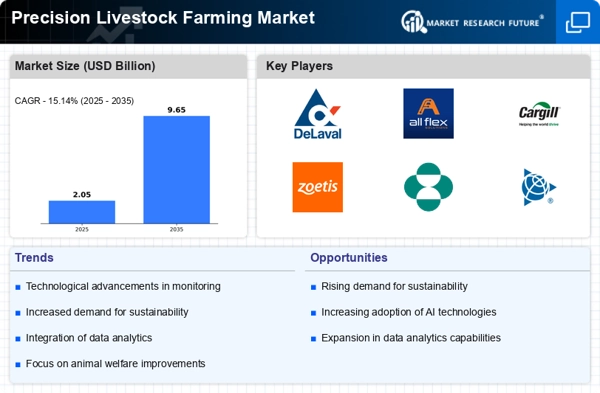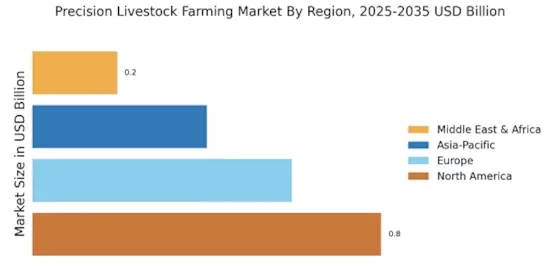Regulatory Support
The Precision Livestock Farming Market is benefiting from supportive regulatory frameworks that encourage the adoption of advanced farming technologies. Governments are increasingly recognizing the importance of precision agriculture in enhancing food security and sustainability. Incentives such as grants and subsidies for technology adoption are being offered, which could potentially increase market participation. For instance, recent initiatives have allocated significant funding to support farmers in integrating precision livestock technologies. This regulatory backing is likely to foster growth within the Precision Livestock Farming Market, as it reduces the financial burden on farmers and encourages innovation.
Sustainability Initiatives
Sustainability is becoming a cornerstone of the Precision Livestock Farming Market. With growing concerns over environmental impact, farmers are adopting practices that minimize waste and enhance resource efficiency. The implementation of precision farming techniques can lead to a reduction in greenhouse gas emissions by up to 30%, aligning with global sustainability goals. Furthermore, consumers are increasingly favoring products that are produced sustainably, which is driving demand for livestock that are raised with minimal environmental impact. This trend is likely to propel the Precision Livestock Farming Market forward as stakeholders seek to meet both regulatory requirements and consumer expectations.
Technological Advancements
The Precision Livestock Farming Market is experiencing a surge in technological advancements that enhance livestock management. Innovations such as IoT devices, AI, and machine learning are being integrated into farming practices, allowing for real-time monitoring of animal health and behavior. This technological integration is projected to increase productivity and reduce operational costs. According to recent data, the adoption of these technologies could lead to a 20% increase in efficiency within the sector. As farmers increasingly rely on data-driven insights, the Precision Livestock Farming Market is likely to expand, driven by the need for improved animal welfare and optimized resource use.
Consumer Demand for Quality
There is a notable shift in consumer preferences towards high-quality, ethically produced livestock products. The Precision Livestock Farming Market is responding to this demand by implementing technologies that ensure better animal welfare and product quality. Data indicates that consumers are willing to pay a premium for products that are traceable and produced under humane conditions. This trend is likely to drive the adoption of precision farming techniques, as farmers seek to enhance the quality of their offerings. As a result, the Precision Livestock Farming Market is expected to grow, fueled by the intersection of consumer demand and technological innovation.
Global Food Security Concerns
Concerns regarding food security are increasingly influencing the Precision Livestock Farming Market. As the global population continues to rise, the demand for efficient livestock production is becoming more pressing. Precision livestock farming techniques are being recognized for their potential to increase production efficiency and reduce resource consumption. Reports suggest that implementing these practices could lead to a 15% increase in livestock productivity. This urgency to address food security challenges is likely to drive investment and innovation within the Precision Livestock Farming Market, as stakeholders seek sustainable solutions to meet future food demands.

















Leave a Comment